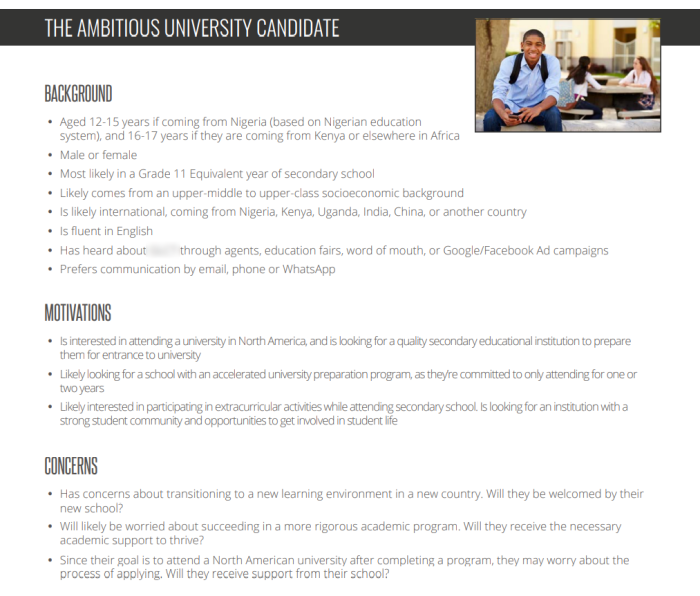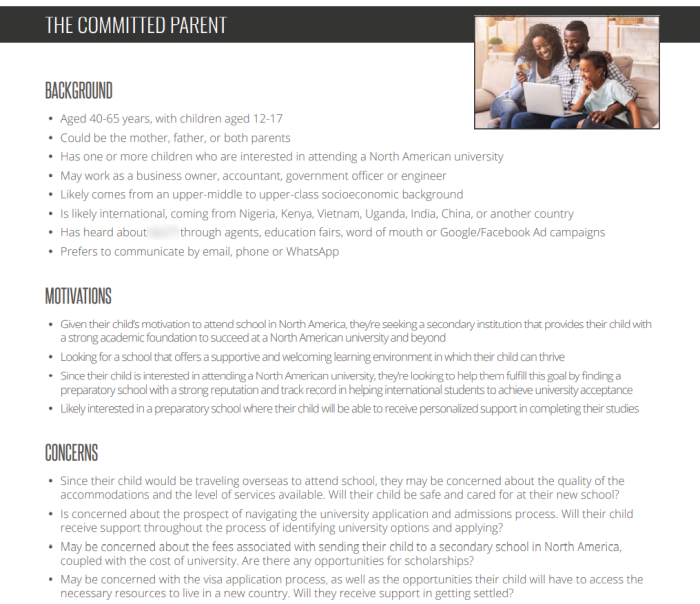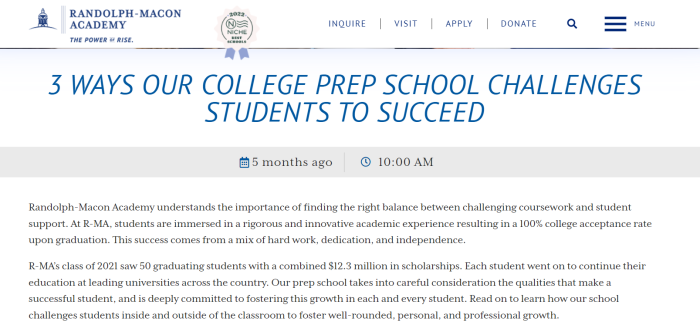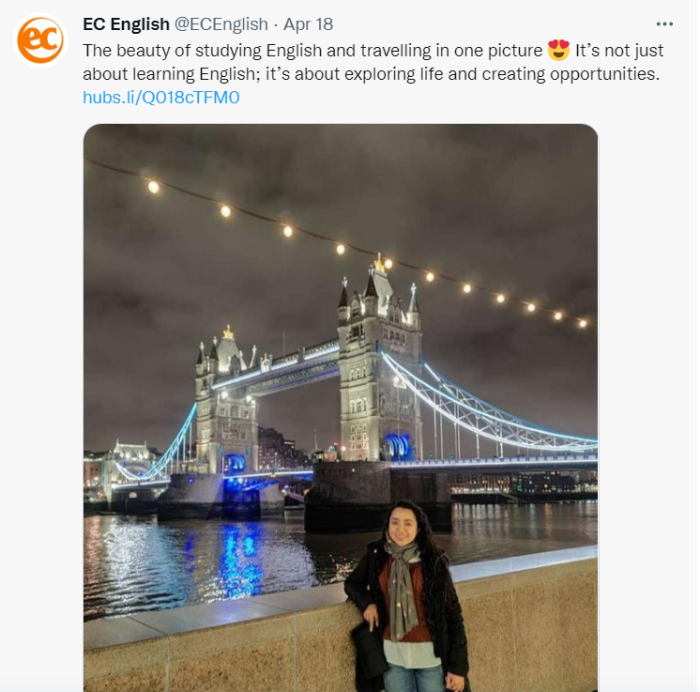Student personas are at the core of nearly every effective marketing strategy. With a student persona, your messages are more likely to make a strong impact, improving your overall outreach efforts. That’s because conducting the necessary research and understanding your audience allows your school to deliver messages that work; ones that resonate with your prospects and compel them to convert.
Going through the process of creating student personas may be time consuming, but it goes a long way in ensuring the success of your digital marketing activities. These student personas can help you create a personalized content strategy that enables prospects to feel seen and cared for by your school. Here, you’ll be addressing their personal needs and concerns—connecting with your prospects in a more meaningful and engaging way. This way, you can build a more dedicated following, nurture deep relationships, and consequently nurture prospects further down the enrollment funnel.
Here’s your school’s guide to getting started!
Breaking down the Key Components of a Student Persona
Student personas can be understood as the “buyer persona” for schools, a semi-fictional representation of your ideal prospect. This representation can also be constructed as a profile based on real data and research, making them particularly valuable to your school’s inbound marketing efforts. Typically, these profiles give you an overview of the key points that introduce your prospect to your school’s team, including the following information:
- A name to reference the prospect and facilitate internal communications
- An accompanying image to provide a visual representation
- Demographic information, such as age, location, socioeconomic background, status, etc.
- Personal motivations, including interests, goals, or other driving factors for enrollment
- Personal concerns like challenges or barriers to applying
The example below describes a university student persona, providing their background information, motivations, and concerns. This compiled list of insights can be used to create a concise snapshot of a school’s target audience for quicker and more effective marketing. When developing persona examples for students, such detailed profiles help tailor marketing strategies to meet the specific needs and preferences of your target audience.

Pro Tip: Consider the advantages of creating a negative student persona—also defined as a semi-fictional representation. This type of persona reflects the type of prospects you don’t want to attract, those who you would consider being the wrong fit for your school. For instance, your school may not want to attract an “undecided” student or one who is “unmotivated” or “uncommitted.”
Knowing what to watch for in terms of demographics, motivations, and concerns can help you refine your messaging so that you only focus your efforts on reaching prospects who would convert.
Analyze Your Existing Data to Better Understand Your Audience
To begin creating your student persona, you can start by analyzing your existing database. Try to identify trends among your current students, such as where they’re coming from, their typical age range, as well as their personal interests, goals, and concerns. You may also want to consider which students gravitate towards different programs, tracking their preferred delivery format as well (online, in-person, or hybrid learning).
In order to create the international student persona below, information was gathered regarding the trends exhibited by current students. Such information includes extra details on which programs have a higher male to female ratio and which programs international students tend to go for.

With this information, you can begin developing a clearer picture of your student majority. This gives you the chance to better understand them and better attract those like them—your ideal prospects. It’s worth mentioning that developing this data and understanding your international prospects can help you enhance your international outreach and student recruitment efforts.
Through this process, you’ll have the opportunity to turn to your school’s digital metrics for information. Consider analyzing the performance of your school’s website and blog to discover where your prospects tend to spend most of their time and attention. It may be worthwhile to compare the content on your most frequently visited pages with those that generate the highest bounce rate. What content has the most traction? And where is your traffic coming from?
By answering these questions, you can discover key data that can help you refine your student personas as well as improve your digital marketing strategy.
Questions to Consider When Looking at Your Data
As you analyze your school’s data, you’ll want to keep a set of questions in mind. Doing so ensures that you extract the right information in order to create accurate and impactful student personas. The questions below serve as a guide that your school can use to create its student persona template. These questions are divided into three main categories: Background, Motivations, and Concerns.
Background:
– Who is the prime decision-maker?
– What is the typical age range and location of your prospects?
– What is the typical socioeconomic background of your prospects?
– How did they discover your school?
– How do they like to communicate?
– What are some of their ideal characteristics?
Motivations:
– What are the main reasons that students choose your school?
– What do your students value most about your school and their experience?
– What sets your school apart from its competition (according to your students)?
-What is the most engaging aspect of your school (according to your students)?
– What are some of your metrics for success (i.e. top rankings, graduation or acceptance rate, etc.)?
Concerns:
-What are some of the common questions or concerns that students typically ask?
-What are common misconceptions that your students have had about your school?
-What are some of your students’ previous challenges or biggest barriers to applying?
The answers to these questions provide your school with the basic insights you’ll need to create accurate and realistic student personas. Once this information has been expanded on and compiled in a clear document, your school will be able to revise its current inbound efforts and make improvements to better target its audience.
Connect with Your Community to Generate the Data You Need
If you don’t have the answers you need, consider reaching out directly to your community and conducting interviews. You can survey current students and alumni to get a bigger picture of your school’s impact and its value—which you can use to review your unique selling proposition and your student personas.
You may also want to turn to your admissions team to analyze lead generation and conversion efforts. By hearing from your school’s active recruiters and admissions teams, you can learn more about the common concerns and driving factors that influence enrollments. This would ultimately speed up your efforts.
Pro Tip: Don’t forget to consider your prospects’ parents, particularly if your students are considered minors. In these cases, parents often play a major role in making the final decision. As such, your school may benefit from creating a parent persona to refine its targeting efforts. The image below showcases how a parent persona might look for a high school:

Conduct Market Research When Creating a Student Persona Template
The information you gather by looking at your digital metrics and speaking to your community will only reflect your school’s specific audience. To get a bigger picture, you’ll want to conduct thorough market research. Here, you may want to look at your competitors’ social media accounts and blogs to analyze how their prospects interact with their content.
In addition to giving you inspiration and insights for your content development strategy, this step can help you round out your analysis and fill out any gaps caused by missing data or information.
One way to help with these efforts is to conduct a general search for programs that are similar to what your school provides. You can also research and track different hashtags on various social media accounts using free or paid social media tools. Doing so allows you to discover and monitor new conversations and trends that may impact how you want to position your school and speak to your prospects.
On that note, you may also want to consider reviewing relevant studies within the higher education sector, including industry blogs or white papers. By going through this process, you may identify new opportunities or industry best practices that can help you more efficiently optimize your digital marketing strategy and boost enrollments.
Craft Compelling Key Messages to Appeal to Your School’s Prospects
Once you’ve gathered your data, you’ll be ready to begin cultivating messages that resonate with your audience. Here, you can include key points about your school that you think are important and relevant for your target audience to know. These points can then be tailored to address the specific concerns and motivations of your college student personas. By doing so, you can hone in on what needs to be focused on in order to more effectively attract, engage, and convert your prospects.
Below is an example of a few key messages developed by HEM to resonate with an English learner persona. These messages are crafted with a clear purpose in mind, highlighting the school’s areas of strength as well as unique selling points.

Each point in these key messages corresponds to a specific motivation or concern listed in the original student persona, illustrating how the school caters to its students’ goals and needs. Schools can refer to these key messages when creating or amplifying their content strategy to better connect with more prospects and boost the impact of their overall digital marketing efforts.
Produce Content that Resonates with Your College Student Personas
Your key messages can serve as a guide for your school. With them in hand, you can identify new topics that would interest your prospects—prompting them to click, read, and follow for more similar content. These topics can be transformed into long-form blog posts, social media messages, short-form videos, email newsletter campaigns, and so much more.
Here, the key is to make sure your new topic is relevant to your readers and viewers. This means making content that accurately reflects the needs and goals of your prospects, which you’ve determined by gathering data and speaking to your existing student community. As a result, you’ll be able to provide your prospects with more value, reinforcing their brand loyalty.
Here are a few examples to help inspire you as you move forward with your student personas:
Creating Blog Content:
To appeal to new prospects and build a stronger sense of community, Randolph-Macon Academy has developed a regularly updated blog. One of its blog posts, shown below, highlights how the school helps its students succeed.

Source: Randolph-Macon Academy
Here, prospects encounter some of the school’s key points—namely how successful graduating students have been at receiving college acceptances and earning scholarships. Prospects looking for a more personalized, high-quality learning experience also learn how Randolph-Macon Academy takes advantage of small class sizes to foster academic growth. Those motivated by personal development may also feel drawn to the school as they continue reading, discovering how they can benefit from existing leadership opportunities.
By integrating these types of key messages into your school’s content strategy, you can attract prospects and showcase how your school is the right fit for them.
Sending Email Newsletters:
You can also adopt a similar approach when creating your school’s email newsletter. Toronto Film School crafted a compelling email subject line that entices interested prospects to open the email. The subject line resonates directly with prospects looking to get hands-on experience with real industry equipment, pushing them to further engage with the school.

Once opened, prospects are greeted with a short message that highlights the unique advantages of the school’s Film Production Diploma program.

Source: Toronto Film School
Using this direct channel ensures that the right prospects are reading your key messages, making them more effective in generating buzz, boosting engagement, and building loyalty.
Crafting Social Media Posts:
Another way to use your school’s student personas and key messages is by turning to social media. EC English shared a tweet that highlights a key motivating factor for student enrollment.

Source: Twitter
Through compelling copy, EC English focuses on the great experience of studying abroad: exploring life as well as learning English. This speaks directly to the interests and motivations of their prospective students, who are likely seeking the same benefits. The added image in the tweet also serves to personalize the message all while showcasing the school’s community—making it all the more appealing.
By understanding your prospects and creating content that reflects your student personas, you can take active steps to effectively attract their attention and inspire them to explore your school’s offerings more deeply. In this way, you can apply these personas to improve your marketing efforts across various digital marketing channels.
Revisit Your Student Persona Regularly to Optimize Your Efforts
It’s important to note that your personas for higher education marketing may change over time. That can be due to a variety of external factors as the world evolves and new trends are introduced. You may even discover that your student persona no longer reflects your current target audience, making it outdated and ineffective. Alternatively, you may discover an opportunity to target a new audience, which would make creating another persona necessary.
Regardless of the situation, you’ll want to regularly revisit your efforts and optimize your personas to drive positive results and boost engagement. You can do this by sending out email surveys to current students or by analyzing your school’s website and social media engagement data. These changes would then naturally trickle into your school’s content strategy, making it more effective at generating student enrollments.







